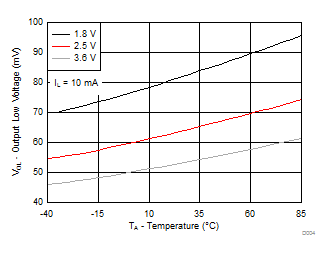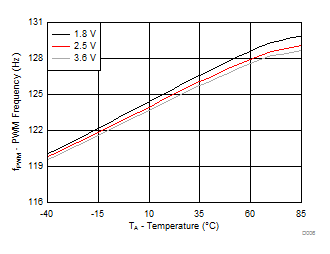SCPS164D MAY 2007 – February 2017 TCA6507
PRODUCTION DATA.
- 1 Features
- 2 Applications
- 3 Description
- 4 Revision History
- 5 Pin Configuration and Functions
- 6 Specifications
- 7 Parameter Measurement Information
-
8 Detailed Description
- 8.1 Overview
- 8.2 Functional Block Diagram
- 8.3 Feature Description
- 8.4 Device Functional Modes
- 8.5 Programming
- 8.6
Register Maps
- 8.6.1 Registers 0x00 - 0x02 (Select Registers)
- 8.6.2 Register 0x03 (Fade-ON Time)
- 8.6.3 Register 0x04 (Fully-ON Time)
- 8.6.4 Register 0x05 (Fade-OFF Time)
- 8.6.5 Register 0x06 - 0x07 (Fully-OFF Time)
- 8.6.6 Register 0x08 (Maximum Intensity per Bank)
- 8.6.7 Register 0x09 (One-Shot / Master Intensity)
- 8.6.8 Register 0x0A (Initialization Register)
- 9 Application and Implementation
- 10Power Supply Recommendations
- 11Layout
- 12Device and Documentation Support
- 13Mechanical, Packaging, and Orderable Information
Package Options
Mechanical Data (Package|Pins)
Thermal pad, mechanical data (Package|Pins)
- RUE|12
Orderable Information
6 Specifications
6.1 Absolute Maximum Ratings
over operating free-air temperature range (unless otherwise noted)(1)| MIN | MAX | UNIT | ||||
|---|---|---|---|---|---|---|
| VCC | Supply voltage | –0.5 | 4.6 | V | ||
| VI | Input voltage(2) | –0.5 | 6.5 | V | ||
| VO | Output voltage(2) | 6.5 | V | |||
| IIK | Input clamp current | VI < 0 | SCL, EN | ±20 | mA | |
| IOK | Output clamp current | VO < 0 or VO > VCC | P port, SDA | ±20 | mA | |
| IOL | Continuous output low current | VO = 0 to VCC | P port | 50 | mA | |
| SDA | 25 | |||||
| ICC | Continuous current through GND | 250 | mA | |||
| Continuous current through VCC | 20 | |||||
| Tstg | Storage temperature | –65 | 150 | °C | ||
(1) Stresses beyond those listed under Absolute Maximum Ratings may cause permanent damage to the device. These are stress ratings only and functional operation of the device at these or any other conditions beyond those indicated under Recommended Operating Conditions is not implied. Exposure to absolute-maximum-rated conditions for extended periods may affect device reliability.
(2) The input negative-voltage and output voltage ratings may be exceeded if the input and output current ratings are observed.
6.2 ESD Ratings
| VALUE | UNIT | |||
|---|---|---|---|---|
| V(ESD) | Electrostatic discharge | Human-body model (HBM), per ANSI/ESDA/JEDEC JS-001(1) | ±2000 | V |
| Charged-device model (CDM), per JEDEC specification JESD22-C101(2) | ±1000 | |||
(1) JEDEC document JEP155 states that 500-V HBM allows safe manufacturing with a standard ESD control process.
(2) JEDEC document JEP157 states that 250-V CDM allows safe manufacturing with a standard ESD control process.
6.3 Recommended Operating Conditions
over operating free-air temperature range (unless otherwise noted)| MIN | MAX | UNIT | ||||
|---|---|---|---|---|---|---|
| VCC | Supply voltage of I2C registers, oscillator, and control logic | 1.65 | 3.6 | V | ||
| VIH | High-level input voltage | SCL, SDA, EN | 1.65 V ≤ VCC ≤ 1.95 V | 1.3 | 3.6 | V |
| 1.96 V ≤ VCC ≤ 3.6 V | 0.7 × VCC | 3.6 | ||||
| VIL | Low-level input voltage | SCL, SDA, EN | 1.65 V ≤ VCC ≤ 1.95 V | –0.5 | 0.3 | V |
| 1.96 V ≤ VCC ≤ 3.6 V | –0.5 | 0.3 × VCC | ||||
| VO | Output voltage | 0 | 5.5 | V | ||
| IOL | Low-level output current (1) | 40 | mA | |||
| TA | Operating free-air temperature | –40 | 85 | °C | ||
(1) The total current sourced by the P port must be limited to 200 mA.
6.4 Thermal Information
| THERMAL METRIC(1) | TCA6507 | UNIT | |||
|---|---|---|---|---|---|
| PW (TSSOP) | ZXU (BGA MICROSTAR JUNIOR) | RUE (X2QFN) | |||
| 14 PINS | 12 PINS | 12 PINS | |||
| RθJA | Junction-to-ambient thermal resistance | 127.2 | 155.2 | 181 | °C/W |
| RθJC(top) | Junction-to-case (top) thermal resistance | 55.8 | 99.4 | 80.4 | °C/W |
| RθJB | Junction-to-board thermal resistance | 38.9 | 91.5 | 95.3 | °C/W |
| ψJT | Junction-to-top characterization parameter | 9.3 | 6.8 | 3.5 | °C/W |
| ψJB | Junction-to-board characterization parameter | 68.3 | 92.1 | 95.3 | °C/W |
(1) For more information about traditional and new thermal metrics, see the Semiconductor and IC Package Thermal Metrics application report.
6.5 Electrical Characteristics
GND = 0 V, TA = –40°C to +85°C| PARAMETER | TEST CONDITIONS | VCC | MIN | TYP(1) | MAX | UNIT | |
|---|---|---|---|---|---|---|---|
| fINT | Intensity control clock frequency | Operating mode | 1.65 V to 3.6 V | 28 | 32 | 58 | kHz |
| VIK | Input diode clamp voltage | II = –18 mA | 1.65 V to 3.6 V | –1.2 | V | ||
| VPOR | Power-on reset voltage | VI = VCC or GND, IO = 0 | 1.65 V to 3.6 V | 1.1 | 1.4 | V | |
| VOL | SDA | IOL = 6 mA | 1.65 V to 3.6 V | 0.2 | 0.6 | V | |
| IOL | SDA | 1.65 V to 3.6 V | 3 | 13.2 | mA | ||
| P port(2) | VOL = 0.5 V | 1.65 V | 25 | 59.7 | mA | ||
| VOL = 0.6 V | 1.8 V to 3.6 V | 40 | 68 | ||||
| II | SCL, SDA, EN | VI = VCC or GND, VCC ≥ 1.65 V | 1.65 V to 3.6 V | ±0.1 | μA | ||
| ICC | Standby current | EN disabled, P port idle, Intensity control disabled, SCL = VCC, SDA = VCC, IO = 0, fSCL = 0 |
1.65 V to 1.95 V | 2 | 12 | μA | |
| 1.96 V to 3.6 V | 3 | 15 | |||||
| Operating mode | P port running, Intensity control enabled, SCL = VCC, SDA = VCC, IO = 0, fSCL = 0 |
1.65 V to 1.95 V | 9.7 | 17 | μA | ||
| 1.96 V to 3.6 V | 10.4 | 20 | |||||
| P port running, Intensity control enabled, SDA = VCC, IO = 0, fSCL = 400 kHz, tr = 300 ns |
1.65 V to 1.95 V | 10.2 | 18 | ||||
| 1.96 V to 3.6 V | 11.4 | 40 | |||||
| Ci | SCL | 1.65 V to 3.6 V | 7 | 10 | pF | ||
| Cio | SDA | VIO = VCC or GND | 1.65 V to 3.6 V | 8 | 11 | pF | |
| Co | P port | VO = VCC or GND | 1.65 V to 3.6 V | 7 | 10 | pF | |
(1) All typical values are at TA = 25°C.
(2) The total current sourced by the P port must be limited to 200 mA.
6.6 I2C Interface Timing Requirements
over recommended operating free-air temperature range (unless otherwise noted) (see Figure 8)6.7 Oscillator Timing Requirements
over recommended operating free-air temperature range (unless otherwise noted)| MIN | MAX | UNIT | ||
|---|---|---|---|---|
| STANDARD and FAST MODE | ||||
| tOSC | Oscillator start-up time from power-down or shutdown mode to fully on at 32 kHz | 5 | ms | |
6.8 Switching Characteristics
over recommended operating free-air temperature range, CL ≤ 100 pF (unless otherwise noted)6.9 Typical Characteristics
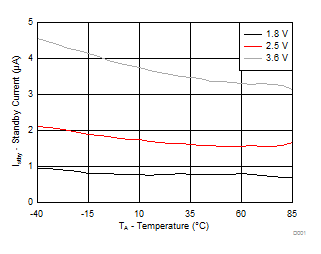
| EN is Low (PWM Disabled) | fSCL = 0 | |
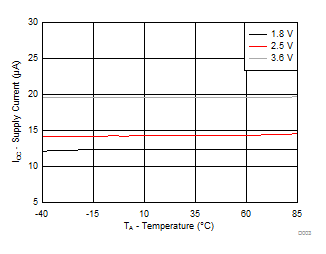
| EN is High (PWM Enabled) | fSCL = 400 kHz | |
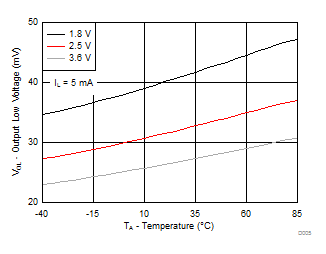
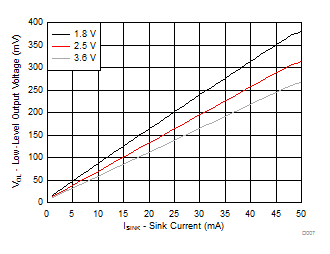
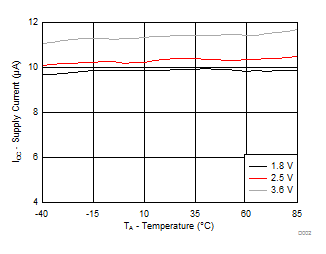
| EN is Low (PWM Enabled) | fSCL = 0 | |
